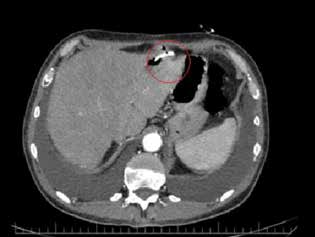Abstrakt
Úvod: Perkutánna endoskopická gastrostómia (PEG) patrí medzi efektívne spôsoby zabezpečenia dlhodobej enterálnej výživy u pacientov s nemožnosťou orálneho príjmu. Komplikácie zavedenia sú pomerne časté. Medzi najčastejšie patrí peristomálna infekcia rany v mieste zanorenia a presakovanie obsahu pozdĺž kanyly. Menej časté sú kolo-kutánne fistuly a peritonitída. Veľmi zriedkavou komplikáciou je absces pečene.
Kazuistika: Autori popisujú prípad 51 ročného muža s hepatálnym abscesom a s inoperabilným karcinómom faryngu so zavedenou PEG. Pacient bol prijatý do nemocnice s rozvíjajúcim sa septickým stavom, ktorého príčinou bol absces pečene. Absces pečene vznikol na základe zanorenia disku PEG a jeho následnou úplnou dislokáciou do oblasti ľavého laloka pečene. Uvedený stav bol riešený chirurgickou revíziou s drenážou abscesu a konštrukciou klasickej gastrostómie.
Záver: Syndróm zanoreného disku PEG s komplikáciou ako je absces pečene, je pomerne zriedkavá komplikácia, no prináša výzvy v podobe diagnostiky aj terapie samotného syndrómu. Manažment liečby vyžaduje úzku spoluprácu gastroenterológa a chirurga. Včasné rozpoznanie a riešenie môže zabrániť progresii stavu do sepsy, resp. až do septického šoku, čo môže viesť až ku smrti.

